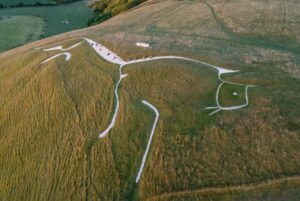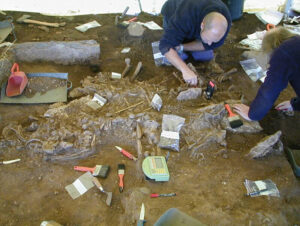A mass grave discovered in Northern England last year could offer new insight into a poorly understood part of the country’s history.
Archaeologists discovered 62 people in graves believed to be 1,600 years old, dating back to the invasion of Anglo-Saxons following the end of Roman-controlled Britain. The skeletons include men, women, and children, as well as a late-Roman aristocrat — all found in a hidden cemetery in the city of Leeds.
The varied remains likely include people from both the late Roman and early Saxon era, as burial customs of both eras were found in the graves, according to a press release last week from the Leeds City Council.
Historians and archaeologists hope the discovery can help them paint a clearer picture of the mostly undocumented transition between the fall of the Roman Empire around 400 AD and the establishment of the famed Anglo-Saxon kingdoms, also known as the Dark Ages.
British archaeologists uncovered a 1,600-year-old coffin in England, a discovery, they said, that could shed light on the area’s transition from the Roman Empire to its Anglo-Saxon period. They also found the ancient remains of more than 60 people.https://t.co/s9UnBfdHYV pic.twitter.com/HvJNhQ0E75
— The New York Times (@nytimes) March 15, 2023
Most of the digging has finished and the researchers have started their analysis. That includes carbon dating to establish more exact time frames and chemical tests. And those could provide details about individual diets and ancestry, the press release said.
Officials waited a year to release news of the discovery to keep the site safe. Archaeologists quoted in the release sound thrilled to work on the project.
“It is every archaeologist’s dream to work on a ‘once in a lifetime’ site, and supervising these excavations is definitely a career-high for me,” said Kylie Buxton, supervisor for the excavations. “There is always a chance of finding burials, but to have discovered a cemetery of such significance, at such a time of transition, was quite unbelievable.”

An archaeologist displays one of the many Roman artifacts discovered in graves in Northern England last year. Photo: West Yorkshire Joint Services
Trying to understand the Dark Ages
The Roman occupation of Britain transformed the area’s culture, controlling most of the country from about 43 to 410 AD. It brought settlers from Europe, the Middle East, and Africa. Many new towns began, and Roman objects spread throughout the region, especially in the third century, according to English Heritage, which manages prehistoric sites, medieval castles, and Roman forts in England.
Then the Romans left, and the so-called Dark Ages began.
“The six-and-a-half centuries between the end of Roman rule and the Norman Conquest are among the most important in English history,” English Heritage wrote. “This long period is also one of the most challenging to understand –- which is why it has traditionally been labeled the ‘Dark Ages.'”
Researchers hope the graves and artifacts within them can shed some new light on the period. For example, they’d like to understand why several graves contained two to three people and why there were multiple burial styles in the same cemetery.
The discovery of a lead-lined coffin is also relatively rare, although a few hundred others have also turned up in Britain, said Buxton.
“This has the potential to be a find of massive significance for what we understand about the development of ancient Britain and Yorkshire,” said David Hunter, principal archaeologist with West Yorkshire Joint Services.






